|
What is the Origami Cube?,
…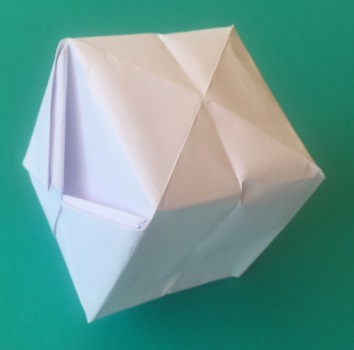 |
Der Origami-Würfel ist ein Würfel, den Sie aus einem quadratischen Blatt Papier falten können.
Ein anderer Name ist Wasserbombe. |
Falttheorigami Cubetop
1
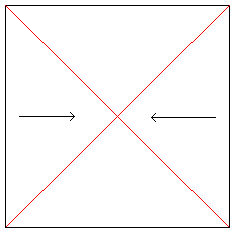 |
Falten Sie ein quadratisches Blatt Papier in den Diagonalen und entfalten.
Legen Sie das Papier an beiden Pfeilen zusammen. |
2
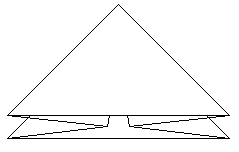 |
The result is a flier triangle, which is known from theswallow or the pigeon. |
3
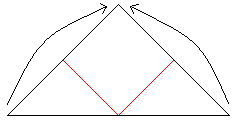 |
Fold upward on the red line on the right and on the left., |
4
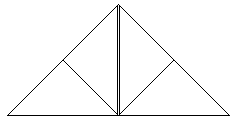 |
Then it must look like this. |
5
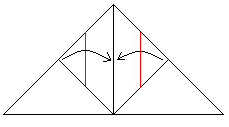 |
Fold on the red lines., |
6
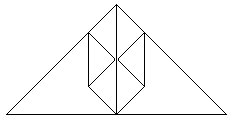 |
Then it must look like this. |
7
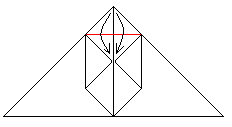 |
Fold the two little triangles on the red lines downward., |
8
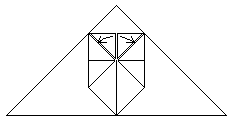 |
Put the last made triangles in the two pockets on theright and on the left. This is a little bit fiddly. |
9
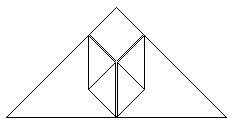 |
Then it must look like this., |
10
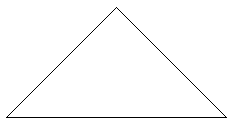 |
Turn the whole triangle and repeat the steps 3,4,5,6,7,8,9. |
11
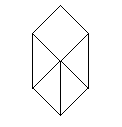 |
Then it must look like this., |
12
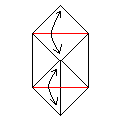 |
Fold and unfold on the red lines. |
13
 |
Take the folded cube in hand and blow into the hole atthe top. Unfold the cube by this., |
14
 |
finished |
Some Mathematics top
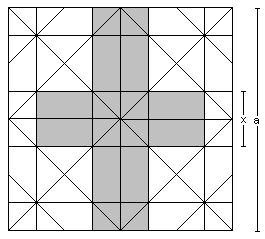 |
If you take the cube apart, you get a nice pattern, whichis made by the folds.
You find the formulas: ………, |
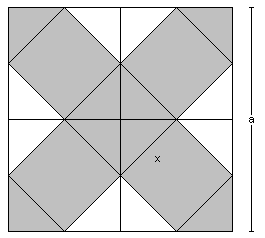 |
Auf der linken Seite sehen Sie das größte Netz von einem Würfel, whichfits ein Quadrat.
Sie finden die Formeln:
Dieser Würfel ist viel größer als der gefaltete Würfel., |
Wenn Sie das ganze Quadrat für einen Würfel verwenden möchten, haben Siedie Formel:![]() Dies ist theoretisch der größte Würfel.
Dies ist theoretisch der größte Würfel.
Mehr dazu in Buch (5), Seite 63f. und Seite 71ff. „Dereingewickelte Würfel“.
OrigamiCube auf der Internet
Deutsch
Dr. Stephen O ‚ Hanlon (Ring der Origami-Kunst)
WaterBomb ( .,pdf file)
Gerwin Sturm (Origami for everyone)
Waterbomb
Puzzle Playground (Puzzle_com)
Squareto Cube
Wikipedia
Waterballoon
Deutsch
Jennifer’sPuzzle
Flechten eines Würfels aus 3 Streifen
Umwelthaus Pinneberg e.V.,
Wasserbombeaus Papier
Wikipedia
Wasserbombe(Spielzeug)
zzzebra
Wasserbombe
References top
(1) Joachim Schönherr, Wir falten und falzen, Leipzig1990
(2) Therese Mielhaht: Origami Spaß mit Papierfalten,Köln 1990
(3) Kunihiko Kasahara: Origami – figürlich und geometrisch,München 2000
(4) Kunihiko Kasahara: Origami – ohne Grenzen, München2001
(5) Martin Gardner: Mathematische Hexereien, Berlin/Frankfurtam Main/Wien 1988